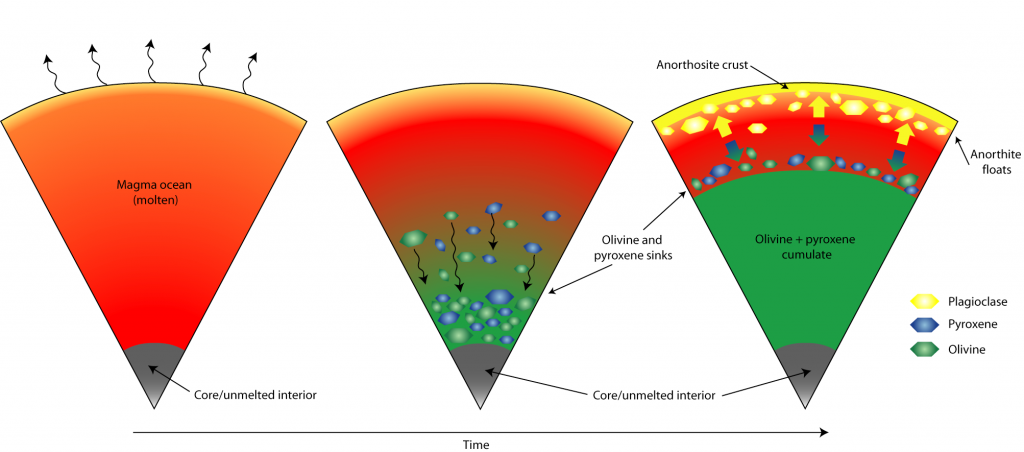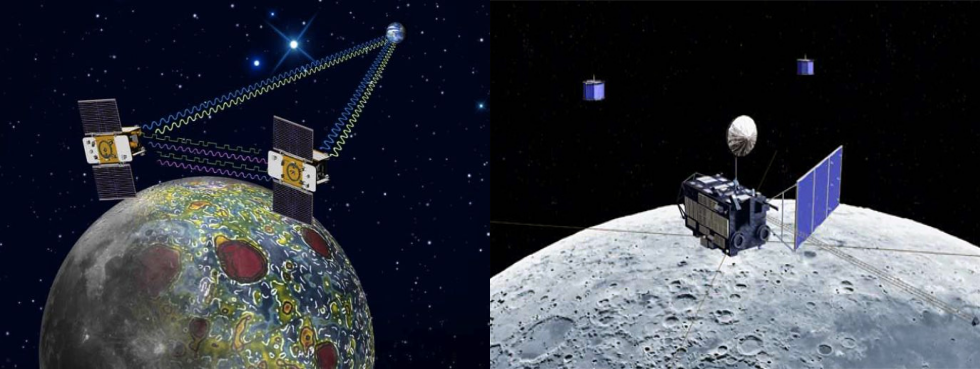Interior of the Moon
The Moon, like our own planet and other rocky bodies in the solar system, is build up off layers that comprise different rocky material. When the Moon first formed, all of the heavy material (e.g., iron) sunk down towards the core and all the lighter material (e.g., plagioclase and silica-rich crystals) rose up to the surface. This led to the formation of a dense metallic core comprising iron, some nickel, and traces of lighter elements such as sulphur. The core has two components, an inner and outer layer. The inner core is a solid iron-rich mass ~480 km in diameter, while the outer core is a fluid that extends the cores diameter to ~660 km. It is the outer core that generates a magnetic field when the material rotates around the inner core. For Earth, its outer core is still active and hot, generating a strong magnetic field protecting life from harsh solar radiation and storms. For the Moon, however, the outer core is no longer active and its magnetic field has diminished completely. Compared to the entire diameter of the Earth, the Moons’ core is small (only 20% of the Moons total diameter). For size reference, other terrestrial bodies cores are closer to 50% of their diameters.
As you rise above the core, you reach the mantle and crust of the Moon. The mantle and crust are of particular interest to the lunar science community because differences in their compositions tell a story of when the Moon was entirely covered, or almost entirely, in a magma ocean. The mantle and crust formed when this magma ocean began to cool and crystals sunk and rose towards the surface. Heavier minerals such as olivine and pyroxene sank towards the base of the magma ocean, while light minerals such as plagioclase feldspar floated to surface to form the lunar anorthosite crust. The mantle has a rough thickness of 1338 km (Earth’s for reference is ~2900 km). What is very interesting about the lunar crust is it is thinner on the nearside and thicker on the farside; the crust has an average thickness of ~60 km on the nearside and ~100 km on the farside. The origin of the crust’s heterogenous thickness is still a topic of debate amongst scientists, but the most accepted hypotheses is that the nearside was impacted by multiple large meteorite projectiles that impacted, uplifted, consumed a lot of the crust, while the farside experienced very little.

Encyclopædia Britannica, Inc.

Measuring the Stratigraphy and Structure
For more than 50 years, the most detailed and high-resolution geophysical data on the Moon’s interior has come from seismic experiments set up by Apollo astronauts. These experiments recorded the seismic activity on the Moon until late 1977 (known as the Apollo Lunar Surface Experiments Package (ASLEP). Since then, we have relied on magnetic and gravity-based remote sensing data collected from a variety of lunar orbiter missions, including the NASA Gravity Recovery and Interior Laboratory (GRAIL), and the lunar radar sounder on the Japanese Space Agency (JAXA) Selenological and Engineering Explorer (SELENE) spacecraft.

Remote sensing data has provided scientists with a relatively large amount of information regarding the shallow interior structure of the Moon, but to acquire detailed information, we need to send seismic, magnetic, and gravimeter instruments to multiple locations across the lunar surface (preferably on regions where Apollo astronauts never touched).
At Simon Fraser University in British Columbia, Canada, a team led by Professor Behraad Bahreyni are creating miniaturized seismometers and gravimeters designed to be mounted on the undercarriage of lunar rovers. Their devices will be able to produce precise seismic and gravimetric models of the lunar subsurface, improving our understanding of the lunar interior as well as providing insights that can contribute towards future exploration and habitation on the Moon. Dr. Behraad Bahreyni’s work is funded through the Canadian Space Agency Lunar Exploration Accelerator Program and the federal Ministry of Innovation, Science and Industry. Dr. Behraad’s team comprises researchers from Simon Fraser University, the University of Manitoba, and McGill University.
